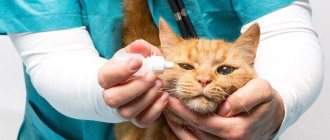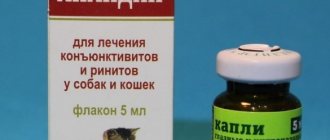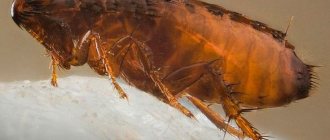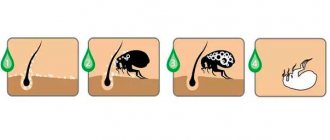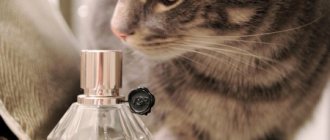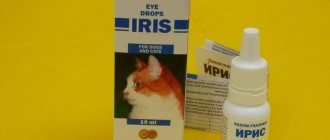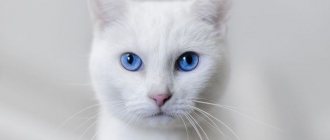If pets have problems with the visual organs, then owners need to urgently contact a veterinarian. Eye drops for cats are a frequently used and easy-to-use product. At the veterinary pharmacy you can purchase anti-inflammatory, antiviral, and antibiotic medications. You should not use human drops for vision problems in cats without the knowledge of a specialist, since there is a high probability of complications.
Composition and action
Iris drops are antibacterial drugs. The veterinary medicinal product contains gentamicin sulfate, an antibacterial substance active against gram-positive and gram-negative bacteria, including Pseudomonas aeruginosa. Drops are used for topical use.
Important!
The drug is ineffective against pathogenic fungi, viruses, protozoa and anaerobic bacteria (which do not require oxygen for development and reproduction).
When applied topically, gentamicin sulfate begins to act quickly. Once on the conjunctival mucosa, the substance penetrates the cornea, then reaches the required concentration in the intraocular environment and has a therapeutic effect.
Table: analogues of Iris eye drops for cats
| Name | List of components, application features | Dosage and use (all eye medications are instilled into the conjunctival sac, that is, behind the lower eyelid of the eye) | Price |
| Bars, AVZ. | A combination drug containing active substances:
Has a slight analgesic effect when used. | Application schemes:
| 10 ml bottle: 151–200 rub. |
| Tsiprovet, AVZ. | The active ingredient is ciprofloxacin hydrochloride (0.45%). The drug is used to prepare for eye surgeries and during the rehabilitation period after them. | One drop four times a day for 1–2 weeks until complete recovery. If there are purulent discharges, they are first removed with a tampon soaked in the same drug. | 10 ml bottle: RUR 166–219 |
| Anandin, Mediter LLC, St. Petersburg. | Active ingredient: anandin 2%. Stimulates regeneration processes during mechanical and chemical injuries of mucous membranes and skin. In addition to the treatment of conjunctivitis, the drug is used in the treatment of rhinitis. | For ophthalmic diseases, drop two drops twice a day until complete recovery, but not more than fourteen days. | 5 ml bottle: 70–98 rub. |
| Dezatsid, JSC "Agrobioprom". | Active ingredients:
Sodium chloride and purified water are used as auxiliary components. Helps normalize intraocular pressure, is a means of preventing the development of ophthalmological diseases of the cornea, and is used to treat dermatitis of the skin around the eyes. | The drug must be shaken before use. After this, a hygienic procedure is carried out to treat the fur around the eyes and the exudate is removed (using a swab moistened with medicine). For cats, the drug is given one drop at a time. The number of treatments depends on the therapeutic purpose:
To treat dermatitis, the medicine is applied to the affected area three times a day until clinical healing. | 10 ml bottle: 168–190 rub. |
| Diamond eyes, AVZ. | Compound:
Prevents the development of cataracts and dystrophic changes in the retina and lens of the eye. | For minor inflammatory diseases, injuries, large lacrimation, the drug is dripped three times a day, one drop at a time. If necessary, pre-clean the eyes from purulent exudate with a sterile swab moistened with the same solution. You can use it for two weeks, then take a break of five days and the course can be repeated. To prevent cataracts and age-related changes in the eye, the medicine is instilled twice a day, one drop. Application regimen: after twenty days of use, ten days break. | 10 ml bottle: RUR 174–229 |
| Dekta-2, API-SAN LLC. | The composition includes active ingredients:
Auxiliary components:
Reduces allergic reactions and is also used in the postoperative period. | Application procedure:
| 5 ml bottle: 115–154 rub. |
| Lakrikan, CJSC "Top-Vet". | Active components:
Excipients:
It has local anesthetic, enveloping and deodorizing properties, and helps normalize tear production. | The drug is used for hygienic treatment and treatment of inflammatory processes of bacterial origin. The course of therapy is about 9 days and includes instilling the medicine one drop three times a day. | 10 ml bottle: 56–63 rub. |
Photo gallery: veterinary ophthalmic drops
Bars drops are prescribed for the treatment of acute and chronic conjunctivitis, keratitis, keratoconjunctivitis and blepharitis. Ciprovetin drops are effective against most gram-positive and gram-negative microorganisms, including strains resistant to gentamicin
Anandin drops have a wound healing effect
Desacid drops, due to the presence of bee jelly, help reduce intraocular pressure Eye drops Diamond eyes are also used to prevent cataracts
Some cat owners use non-veterinary eye drops to combat conjunctivitis in their pets, acting on the principle: what helps us will help the cat. Of course, a therapeutic effect can be achieved. But you still need to take into account that the concentration of active substances in human medications is not intended for use by four-legged pets. This treatment may cause problems with the kidneys, liver, or other organs.
Purpose
Eye drops are used as prescribed by a veterinarian for diseases of the organ of vision if they are caused by aerobic bacteria. The drug has shown its effectiveness in treating cats:
- traumatic eye injuries;
- blepharitis;
- keratitis;
- conjunctivitis and keratoconjunctivitis;
- dacryocystitis;
- iritis and other eye diseases.
For mechanical damage to the cornea and ulcers, Iris is used as a decongestant and healing agent.
Eye diseases in cats
A common eye disease in pets is blepharitis. This is an inflammation of the edges of the eyelids, which has many causes. This:
- bacteria (usually pyogenic cocci);
- food allergies, etc.;
- eye injury;
- the presence of subcutaneous mites;
- helminth infection;
- seborrhea – the presence of dandruff, dry scales on the eyelids;
- problems of the endocrine system, etc.
It is believed that Persian and British breeds (and others with flattened faces) have a genetic predisposition to eyelid inflammation. The reason is the structural features of the lacrimal canals.
The main symptoms of blepharitis are swelling and redness of the eyelids, itching, and constant watery eyes. The cat experiences discomfort and scratches its eyes, thereby injuring them even more.
Inflammation of the cornea, the transparent membrane of the eye, is called keratitis. With it, clouding of the cornea can be observed (the owner may notice a whitish spot on the cat’s eye). Pathology can be acute or chronic. In the first case, the disease develops rapidly. Typically, acute keratitis develops against the background of other diseases - viral enteritis, hepatitis, infectious eye diseases. Manifested by lacrimation, photophobia. If a bacterial infection is added to the pathology, the tear becomes cloudy and mucus and pus appear in it.
Chronic keratitis is often a complication of conjunctivitis, viral diseases, and dry eye syndrome. Lack of treatment can result in decreased vision or complete blindness.
Indications and contraindications for use
The use of this remedy - a drug for the treatment of diseases of the organs of vision - is recommended for the penetration of pathogenic microorganisms into the eyes, acute and chronic forms of conjunctivitis, keratitis, meibomitis, ulcers and erosions of the cornea, uveitis, blepharitis, keratoconjunctivitis. Can be used to prevent complications after suffering ophthalmological pathologies. It is used for mechanical damage to the eyes, foreign bodies and small debris entering the organs of vision.
The use of the drug is prohibited if the pet is hypersensitive to the components. If the cat is pregnant, you should also stop using these drops and choose another medicine. Before use, consult a veterinarian and read the instructions for the drops.
Side effects are rare. Irritation may occur upon first use. If this happens, you should stop using the drug and contact your veterinarian.
Treatment rules
Treatment results can only be achieved by following the treatment regimen. It involves regular eye drops, 4 times a day at equal intervals. Regardless of the weight of the pet, you need to bury 1 drop in each eye. Even if the inflammatory process affects only one eye, you need to drip into both.
The duration of therapy will be determined by the veterinarian who monitors the pet during the illness. Typically, antibiotics are prescribed for a course of 5-7 days, the maximum duration of treatment is 10 days.
Drops can be used to prevent complications, prevent inflammatory processes after a foreign body or irritant gets into the eye. In this case, you need to drip for 3 days, four times a day.
Characteristics of Iris eye drops for cats
The drug Iris is a translucent solution of light yellow color, which is intended for the treatment of ophthalmic diseases in cats and dogs. Sold in veterinary pharmacies without a doctor's prescription, can be ordered in online stores. Cost of a bottle (10 ml): from 130 rub. up to 210 rub.
Composition and release form
Iris drops are produced by the domestic Research and Development Plant (AVZ), founded in 1993. The drug is available in 10 ml plastic bottles with a dropper, packed in a cardboard box. It also contains detailed instructions for use.
The active ingredient is gentamicin sulfate (0.4%) - an antibiotic that actively affects many types of gram-positive and gram-negative microorganisms. It penetrates the bacterial cell membrane, changes the structure of the cell's ribosomes, which leads to disruption of the microorganism's protein synthesis and its death. The composition also includes a prolongator (increases the duration of action of the active component) and other excipients. The drug is instilled into the conjunctival sac, it is absorbed by the mucous membrane and penetrates the internal tissues of the eye, providing a local therapeutic effect.
Iris drops are used to treat eye diseases in cats and dogs
Indications for use
Iris is an ophthalmic veterinary remedy. It has a bactericidal, anti-inflammatory and regenerating effect, and is used in the treatment of many inflammatory eye diseases:
- conjunctivitis;
- keratitis;
- keratoconjunctivitis;
- ulcers and erosions;
- meibomyitis;
- blepharitis;
- uveitis.
The drug does not affect some types of microorganisms, these include:
- anaerobic bacteria;
- mushrooms;
- viruses;
- protozoa.
Iris drops are the first aid for injuries to the organs of vision, as they protect the body from the development of many types of pathogenic infections.
Directions for use, dosage and side effects
Dosage of the drug Iris for cats is one drop into the conjunctival cavity four times a day . This rate of drug administration is presented in its description on the page of the official website of the AVZ company. The instruction leaflet dated 05/11/2012 states one drop three times a day.
Depending on the purpose, different durations of use are suggested:
- for the treatment of inflammatory processes, therapy is carried out for 1–1.5 weeks;
- as a prophylactic for minor eye injuries or foreign body penetration - three days is enough.
Ophthalmological diseases can have complications with negative consequences (not only blindness, but also death). Treatment is recommended to be carried out under the supervision of a doctor. To properly instill the medicine, the cat's lower eyelid is slightly pulled outward, simply stretching the skin under it with a finger, then the solution is dripped and the eye is lightly stroked. The procedure is performed with an assistant.
Video: how to put drops in a cat’s eyes
Contraindications and side effects when using Iris drops
The instructions indicate that no side effects are observed when the dosage of the drug is taken exactly. Only an allergic reaction is possible if there is intolerance to certain components of the drug. However, the administration of gentamicin sulfate has a negative effect on the functioning of some organs:
- kidney;
- hearing organs;
- vestibular apparatus.
It is not recommended for use during pregnancy and lactation.
Neurotoxic or nephrotoxic drugs, as well as furosimide, ethacrynic acid and hydrocartisone, should not be administered simultaneously with gentamicin. It is incompatible with beta-lactam antibiotics, heparins, and amphotericin.
All these restrictions apply to a greater extent to the intramuscular administration of gentamicin. When used topically to treat eye tissue, it does not have a significant effect on the body.
If symptoms of overdose appear, the use of the medication should be discontinued. These signs include:
- vomit;
- anemia;
- drowsiness;
- tremor.
In severe cases, you need to contact a veterinary clinic. To quickly remove gentamicin from the body, hemodialysis is recommended.
Conditions and shelf life
The drug is stored in a dry and dark place, separate from feed and food. Children and animals should not have free access to it. Temperature range: from +5 to +25 °C. When the packaging is hermetically sealed, the manufacturer guarantees that the properties of the veterinary product will be preserved for 3 years from the date of release. After opening the bottle, Iris can be used for no more than ten days.
Types of eye drops
There are several main types of eye drops:
- Antimicrobial. These include agents that suppress the proliferation of pathogenic microorganisms or destroy them. They can be universal or highly specialized, that is, they kill only certain types of bacteria, viruses or fungi. Most often, the main active ingredient of such drugs is local antibiotics.
- Immunomodulatory. They correct the functioning of the immune system, thereby suppressing the development of viruses and other pathogens. The main active ingredient can be synthetic or natural.
- Anti-allergenic. Such drugs relieve allergy symptoms, reduce swelling and lacrimation. Contain substances that suppress the body's immune response to an irritant. Please note that these drugs do not treat allergies themselves.
- Moisturizing. These products ensure regular and uniform wetting of the eye. Often, succinic or hyaluronic acid is used to create them.
- Metabolic. Accelerate the healing of damaged tissues due to injuries, keratitis, and corneal erosion.
Varieties
At the veterinary pharmacy you can purchase eye drops for conjunctivitis, infections, antibiotic medications and other veterinary products that help with pathologies of the visual organs. At the same time, medications are not only therapeutic, but also preventive. The table shows popular groups of medications that can be used for eye diseases in cats:
| Varieties | Short description |
| Antiseptic | Prescribed for infections, viruses and bacteria |
| Relieves your pet of pus and inflammatory reaction | |
| Antihistamines | Drops in the nose and eyes are indicated for swelling and redness of the mucous membranes |
| Help relieve pain during illness | |
| The action of eye medications is aimed at suppressing the influence of the irritant that caused allergic conjunctivitis | |
| Metabolic or corneoprotectors | Stabilizes visual function in cats |
| Helps maintain normal metabolic processes in the cellular structures of the eye tissues | |
| Prescribed to animals when destructive and degenerative processes appear in the cornea | |
| Moisturizing | Helps relieve dry eyes |
| Reduces redness and swelling | |
| Increases the production of tear fluid |
How to put drops in a cat's eyes
Medicines are instilled directly into the animal's eyes. First of all, try to calm the cat down. Place her on your lap, pet her, talk quietly and calmly
If the animal behaves nervously and aggressively, you can carefully wrap it in a towel
If there is purulent or mucous discharge on the eyes, clean them with a cotton pad soaked in lotion.
Then place one palm on the cat's head, lift it up and use your fingers to open the eyelid. Place one drop and allow your pet to close the eye to distribute the product. Another way is to squeeze a few drops of the drug into the corner of a closed eye, then open the cat’s eyelids.
Repeat the procedure if necessary. At the end, praise your cat and give her a rewarding treat.
The break between instilling different types of drops should be at least 20 minutes.
Hygienic lotions are not instilled, but applied to a cotton pad or napkin, after which they wipe the cat’s eyes from the inner corner to the outer.
Please note that a number of hygiene products can cause staining or discoloration of the fur around the eyes, which is especially undesirable for show animals. In addition to special products, you can use strong black tea or saline solution to clean your eyes.
In addition to special products, you can use strong black tea or saline solution to clean your eyes.
Chamomile decoction is not recommended. One day, my relatives’ Persian cat began to “cry” more than usual, and they tried to solve the problem with chamomile - but after that, in addition to profuse lacrimation, baldness of the area around the eyes was added. The relatives were frightened, suspecting a skin disease, but, as the veterinarian explained, the cause was precisely the decoction - the substances contained in chamomile, when applied externally, lead to hair loss.
Most cats have their eyes cleaned once a day in the morning. For breeds with a natural tendency to tear, such as Persians or Britons, this procedure may be required more often, up to 2-3 times a day.
Release form and storage
In veterinary pharmacies, Iris can be found in cardboard boxes, inside of which there is a bottle with a capacity of 10, 15, 20, 30 ml, or pipettes with 1, 3, 5 ml of the product.
The drug should be stored in a dark and dry place at a temperature of +18..+25 degrees, away from children and animals, away from food.
The shelf life of Iris is 3 years. But from the moment of opening it is reduced to 10 days. Unused medicine must be disposed of.
At the end of the course of use, the packaging must be disposed of. Its use for domestic purposes is prohibited.
Mode of application
Before using Iris drops for a cat, you need to make sure there are no contraindications.
The dosage and course of use should be prescribed by a veterinarian, at least by phone. Otherwise, you can harm the cat without curing the eye disease.
When treating pathologies, it is very important to be able to correctly administer Iris drops to a cat.
A piece of cotton wool should be moistened in a decoction of herbs, boiled water or medicine and wipe the eyes and the area around them.
All crusts and growths must be removed gradually, allowing them to soften a little first. You need to take the drops in one hand and push the cat’s lower eyelid down with the other. After this, you can drop 3-5 drops of Iris into the affected eye. The animal may begin to break free, but it is very important not to let go of it for 3-5 minutes and allow the drug to work. At this time, the animal may experience redness of the eyes, itching and tearing.
But this is only a temporary local reaction to the stimulus, which passes very quickly. The animal's attempts to scratch its eyes must be stopped. After the specified time has passed, the cat needs to be calmed down by simply stroking it gently. Then remove the purulent discharge that appears and drip another 1-2 drops. The procedure should be repeated 3-4 times a day for a week. Hands should be washed with soap after the procedure.
If Iris is used for preventive purposes, then its dose should be reduced to 1 drop twice a day.
It is not recommended to interrupt the course of treatment with the drug. If such a situation does occur, then it should be resumed urgently in the previously indicated dosages.
shutterstock
If an allergic reaction occurs in a cat, you should immediately go to a medical facility, taking with you a bottle of the product or a box of it.
Features of the drug's action
Iris eye drops, penetrating into the conjunctival cavity, are completely absorbed by the connective membrane. They then enter the cornea area. Due to the special composition and texture of the drug, it is evenly distributed throughout all cells of the visual organs. Drops destroy pathogens during infection. In addition, they have a positive effect on the condition of the cornea and connective membrane, as well as the internal structures of the eyes. The drug is used not only as a means of therapy.
It is also used as a prophylaxis against deterioration of the condition after suffering ophthalmological pathologies. In what cases do veterinarians recommend using Iris eye drops? This is covered in the next section.
How to instill: recommendations and precautions
First, the cat’s eyes are cleaned of accumulations of pus and mucus using a cotton pad soaked in chamomile infusion or medicine. The lower eyelid is pulled back and the required amount of eye drops is administered, after which the pet is held for several minutes so that the solution is well absorbed. You should not bring the tip of the bottle close to the animal’s eye, so as not to further injure the mucous membrane. If after use the cat has negative reactions, then stop the treatment and replace the eye drops with an analogue one.
Reviews from veterinarians
Alexey, 32 years old, Chelyabinsk
I often prescribe this drug for the treatment of animals, since adverse reactions occur rarely, the drug is effective and helps well. It is important to follow the dosage and not use the drug after the expiration date: this may worsen the animal’s condition. You must first show your pet to a specialist: in some cases, using an antibiotic will be useless and you will need to select another medicine.
Marina, 44 years old, Novosibirsk
Iris drops are prescribed to dogs and cats for diseases in the field of ophthalmology. They help well if the animal was injured in a fight; If you start using it in a timely manner, you can avoid inflammation. The duration of the course of therapy should be determined by a veterinarian depending on the disease and its severity.
All information posted on the site is provided in accordance with the User Agreement and is not a direct instruction to action. We strongly recommend that before using any product, you must obtain a face-to-face consultation at an accredited veterinary clinic.
